Analytical Investigation on the Effect of Test Setup on Bond Strength
Abstract
1. Introduction
2. Alternative Test Setups Used in the Study of Bond
3. Interface Model and Behavior
4. Finite Element Models
Idealization of Boundary Conditions of the Test Setups
5. Results and Discussion
5.1. Comparison of Longitudinal Stresses in Concrete and Developed Bar
5.2. Comparison of Transverse Stresses
5.3. Comparison of Shear Stresses on Bonded Interface
6. Conclusions
- Conventional pullout setups such as the SPT, SPT-T, and EPT lead to unconservative estimates of bond, reaching values more than double the characteristic bond strength of the interface in relevance to the DTPT, for both the spliced and non-spliced cases.
- Eccentric placement of the test bar, either in the EPT or the BET, creates opposing vectors of the shear stress component τxz, generated by the flexural curvature of the specimen in the test zone. The nominal bond strength values in this case, obtained by averaging the stresses on the bar periphery, have no relevance to the true stress distribution of local bond along the embedded length.
- The DTPTs arguably provides the most conservative estimate of bond strength by engaging solely the bar-to-concrete interface and excluding extraneous confining stresses and by eliminating the flexural response of the specimen. Such a requirement is essential for the study of the characteristic bond properties of reinforced concrete, particularly in yet under-investigated and novel cementitious materials such as UHPFRC and ECC [14,15,47].
- The displacement capacity of the test bars was comparable between the one-bar and spliced models (note than in case of the spliced models the displacement considered is the relative displacement between the bars of the pair, which is twice the magnitude of absolute displacement of one bar). Restriction of the concrete body in the transverse direction, either in the SPT or the continuous non-contact lap splice PT cases produced displacement at peak more than double the corresponding displacement of the laterally unrestrained counterparts.
- Surprisingly, the lateral support provided in spliced pullout setups in the case of continuous concrete strip specimen effected an increase in the bar development capacity on account of passive confinement developing around the test bar. In the absence of such conditions, the peak bond stress and displacement capacity are dependent on the tensile capacity of the surrounding concrete.
- Similar stress field to the Lap Spliced PT setups were observed in the LSBT model. The presence of flexural effects leads to greater variability in the stress fields surrounding the test bars than the pullout setups, with particularly greater intensity in the proximity of the bar located on the side cover of the concrete section thereby promoting side splitting.
- In practical design the development capacity of a bar anchorage may benefit from unaccounted for confinement owing to the arrangement of the structural component, or as a result of the flexural curvature—however these influences, because they usually arise passively as a result of boundary constraints, cannot be accurately quantified in practical applications. It is noted here that the motivating interest of the present work lies in the ability to determine the most conservative, dependable value of bond strength, fbo. In this approach, the extraneous contributions, if they exist, could be considered separately, by rewarding good detailing practice through the reduction of the required anchorage length, in order to account for bond enhancement resulting from confinement and curvature effects. This practice has already been incorporated in existing code provisions, for the contribution of stirrups, larger cover and overbearing axial load [6,13,32,48].
Author Contributions
Funding
Institutional Review Board Statement
Informed Consent Statement
Data Availability Statement
Conflicts of Interest
References
- RILEM/CEB/FIP. Bond of Reinforcement in Concrete—State of the Art. Bulletin No. 10; FIB International: Lausanne, Switzerland, 1970. [Google Scholar]
- ASTM C234-91a. Standard Test Method for Comparing Concrete on the Basis of the Bond Developed with Reinforcing Steel; ASTM International: West Conshohocken, PA, USA, 1991. [Google Scholar]
- RILEM/CEB/FIP. Bond Test for Reinforcing Steel. 2: Pullout Test; Recommendation RC6: Bagneux, France, 1978. [Google Scholar]
- Eligehausen, R.; Popov, E.P.; Bertero, V.V. Local bond stress-slip relationships of deformed bars under generalized excitations. In Proceedings of the 7th European Conference on Earthquake Engineering, Athens, Greece, 20–25 September 1982; pp. 69–80. [Google Scholar]
- Tepfers, R. Theory of Bond Applied to Overlapped Tensile Reinforcement Splices for Deformed Bars. Publ. No. 73:2, Chalmers; University of Technology: Gothenburg, Sweden, 1973. [Google Scholar]
- Orangun, C.O.; Jirsa, J.O.; Breen, J.E. The Strength of Anchor Bars: A Reevaluation of Test Data on Development Length and Splices, Research Report No. 154-3F, Center for Transportation Research; The University of Texas at Austin: Austin, TX, USA, 1975; p. 194. [Google Scholar]
- Orangun, C.O.; Jirsa, J.O.; Breen, J.E. A reevaluation of test data on development length and splices. J. Am. Concr. Inst. 1977, 74, 114–122. [Google Scholar]
- Tastani, S.P.; Pantazopoulou, S.J. Reinforcement and concrete bond: State determination along the development length. J. Struct. Eng. (U. S.) 2013, 139, 1567–1581. [Google Scholar] [CrossRef]
- Metelli, G.; Plizzari, G.A. Influence of the relative rib area on bond behaviour. Mag. Concr. Res. 2014, 66, 277–294. [Google Scholar] [CrossRef]
- Chao, S.H. Bond Characterization of Reinforcing Bars and Prestressing Strands in High Performance Fiber Reinforced Cementitious Composites Under Monotonic and Cyclic Loading. Ph.D. Thesis, University of Michigan, Ann Arbor, MI, USA, 1–9 April 2005. [Google Scholar]
- Tastani, S.P.; Pantazopoulou, S.J. Experimental Evaluation of the Direct Tension-Pullout Bond Test. In Proceedings of the 3rd International Conference on Bond in Concrete, Budapest, Hungary, 20–22 November 2002. [Google Scholar]
- ACI Committee 408. Bond and Development of Straight Reinforcing Bars in Tension, ACI 408R-03; American Concrete Institute: Farmington Hills, MI, USA, 2003; pp. 1–49. [Google Scholar]
- Eurocode 2. Design of Concrete Structures—Part 1-1: General Rules and Rules for Buildings; prEN 1992-1-1:2003E; European Committee for Standardization (CEN): Brussels, Belgium, 2003. [Google Scholar]
- Tóth, M.; Bokor, B.; Sharma, A. Anchorage in steel fiber reinforced concrete–concept, experimental evidence and design recommendations for concrete cone and concrete edge breakout failure modes. Eng. Struct. 2019, 181, 60–75. [Google Scholar]
- Georgiou, A.; Tastani, S.; Pantazopoulou, S.J. Testing Procedure for Determining the Bond-Slip Law of Steel Bars in Strain Hardening Cementitious Composites. Strain Hardening Cem. Based Compos. 2017, 448–456. [Google Scholar] [CrossRef]
- Červenka, V.; Jendele, L.; Červenka, J. ATENA Program Documentation; Cervenka Consulting: Praha, Czech Republic, 2005; pp. 1–282. [Google Scholar]
- Perry, E.S.; Thompson, J.N. Bond Stress Distribution on Reinforcing Steel in Beams and Pullout Specimens. ACI J. Proc. 1966, 63. [Google Scholar] [CrossRef]
- Ferguson, P.M.; Turpin, R.D.; Thompson, J.N. Minimum bar spacing as a function of bond and shear strength. ACI J. Proc. 1954, 50, 869–887. [Google Scholar]
- Lutz, L.A.; Gergely, P. Mechanics of Bond and Slip of Deformed Reinforcement. ACI J. 1967, 64, 711–721. [Google Scholar]
- Kemp, E.L.; Brezny, F.S.; Unterspan, J.A. Effect of rust and scale on the bond characteristics of deformed reinforcing bars. ACI J. Proc. 1968, 65, 743–756. [Google Scholar]
- Cairns, J.; Plizzari, G.A. Towards a Harmonised European bond test. Mater. Struct. Mater. Constr. 2003, 36, 498–506. [Google Scholar] [CrossRef]
- Rex, J.; Sharma, A.; Hofmann, J. A new test specimen to investigate the bond behavior of post-installed reinforcing bars. Struct. Concr. 2019, 20, 583–596. [Google Scholar] [CrossRef]
- ASTM A944-99. Standard Test Method For Comparing Bond Strength of Steel Reinforcing Bars to Concrete Using Beam-End Specimens; ASTM: West Conshohocken, PA, USA, 1999; pp. 501–504. [Google Scholar]
- ASTM A944-10. Standard Test Method for Comparing Bond Strength of Steel Reinforcing Bars to Concrete Using Beam-End Specimens; ASTM International: West Conshohocken, PA, USA, 2015. [Google Scholar]
- RILEM. Bond Test for Reinforcement Steel. 1. Beam Test. RILEM Recommendations for the Testing and Use of Constructions Materials; RILEM: Paris, France, 1982; pp. 213–217. [Google Scholar]
- Malvar, L.J. Bond of reinforcement under controlled confinement. Mater. J. 1992, 89, 593–601. [Google Scholar]
- Tastani, S.P.; Pantazopoulou, S.J. Direct Tension Pullout Bond Test: Experimental Results. J. Struct. Eng. 2010, 136, 731–743. [Google Scholar] [CrossRef]
- De Lorenzis, L.; Rizzo, A.; Tegola, A. A modified pull-out test for bond of near-surface mounted FRP rods in concrete. Compos. Eng. 2002, 33, 589–603. [Google Scholar] [CrossRef]
- Cairns, J.; Jones, K. The splitting forces generated by bond. Mag. Concr. Res. 1995, 47, 153–165. [Google Scholar] [CrossRef]
- Yuan, J.; Graybeal, B.A. Bond Behavior of Reinforcing Steel in Ultra-High Performance Concrete. Eng. Struct. 2015, 1, 228–235. [Google Scholar]
- Tepfers, R. Cracking of concrete cover along anchored deformed reinforcing bars. Mag. Concr. Res. 1979, 31, 3–12. [Google Scholar] [CrossRef]
- fib Task Group 4.5. Bond of Reinforcement in Concrete. Technical Report, fib Bulletin 10; The International Federation for Structural Concrete: Lausanne, Switzerland, 2000. [Google Scholar]
- fib Bulletin No. 72. Bond and Anchorage of Embedded Reinforcement: Technical report, Background to the fib Model Code for Concrete Structures; The International Federation for Structural Concrete: Lausanne, Switzerland, 2010; ISBN 978-2-88394-112-0. [Google Scholar]
- Tastani, S.P.; Brokalaki, E.; Pantazopoulou, S.J. State of Bond along Lap-Splices. ASCE J. Struct. Eng. 2014, 141, 1–14. [Google Scholar] [CrossRef]
- Ngo, D.; Scordelis, A.C. Finite Element Analysis of Reinforced Concrete Beams. ACI J. Proc. 1967, 64, 152–163. [Google Scholar]
- Salari, M.R.; Spacone, E. Finite element formulations of one-dimensional elements with bond-slip. Eng. Struct 2001, 23, 815–826. [Google Scholar] [CrossRef]
- Lowes, L.N.; Moehle, J.P.; Govindjee, S. Concrete-Steel Bond Model for Use in Finite Element Modeling of Reinforced Concrete Structures. ACI Struct. J. 2015, 101, 501–511. [Google Scholar]
- Mazzarolo, E.; Scotta, R.; Berto, L.; Saetta, A. Long anchorage bond–slip formulation for modeling of R.C. elements and joints. Eng. Struct. 2012, 34, 330–341. [Google Scholar] [CrossRef]
- Keuser, M.; Mehlhorn, G. Finite element models for bond problems. ASCE J. Struct. Eng. 1987, 113, 10. [Google Scholar] [CrossRef]
- Lundgren, K.; Gylltoft, K. A model for the bond between concrete and reinforcement. Mag. Concrete Res. 2000, 52, 53–63. [Google Scholar] [CrossRef]
- Brisotto, D.D.S.; Bittencourt, E.; Bessa, V.M.R.D.A. Simulating bond failure in reinforced concrete by a plasticity model. Comput. Struct. 2012, 106–107, 81–90. [Google Scholar] [CrossRef]
- Murcia-Delso, J.; Benson-Shing, P. Bond-slip model for detailed finite-element analysis of reinforced concrete structures. J. Struct. Eng. (U. S.) 2015, 141, 1–10. [Google Scholar] [CrossRef]
- Reinhardt, H.W.; Blaauwendraad, J.; Vos, E. Prediction of bond between steel and concrete by numerical analysis. Mater. Constr. 1984, 2, 1–8. [Google Scholar] [CrossRef]
- Jendele, L.; Cervenka, J. Finite element modelling of reinforcement with bond. Comput. Struct. 2006, 84, 1780–1791. [Google Scholar] [CrossRef]
- Biscaia, H.C.; Chastre, C.; Silva, M.A.G. Double shear tests to evaluate the bond strength between GFRP/concrete elements. Compos. Struct. 2012, 94, 681–694. [Google Scholar] [CrossRef]
- Cox, J.V.; Herrmann, L.R. Development of a plasticity bond model for steel reinforcement. Mech. Cohesive Frict. Mater. 1998, 3, 155–180. [Google Scholar] [CrossRef]
- Zhou, Z.; Qiao, P. Bond behavior of epoxy-coated rebar in ultra-high performance concrete. Construct. Build. Mater. 2018, 182, 406–417. [Google Scholar] [CrossRef]
- Sharma, A.; Eligehausen, R.; Asmus, J. Experimental investigation of concrete edge failure of multiple-row anchorages with supplementary reinforcement. Struct. Concr. 2017, 18, 153–163. [Google Scholar] [CrossRef]
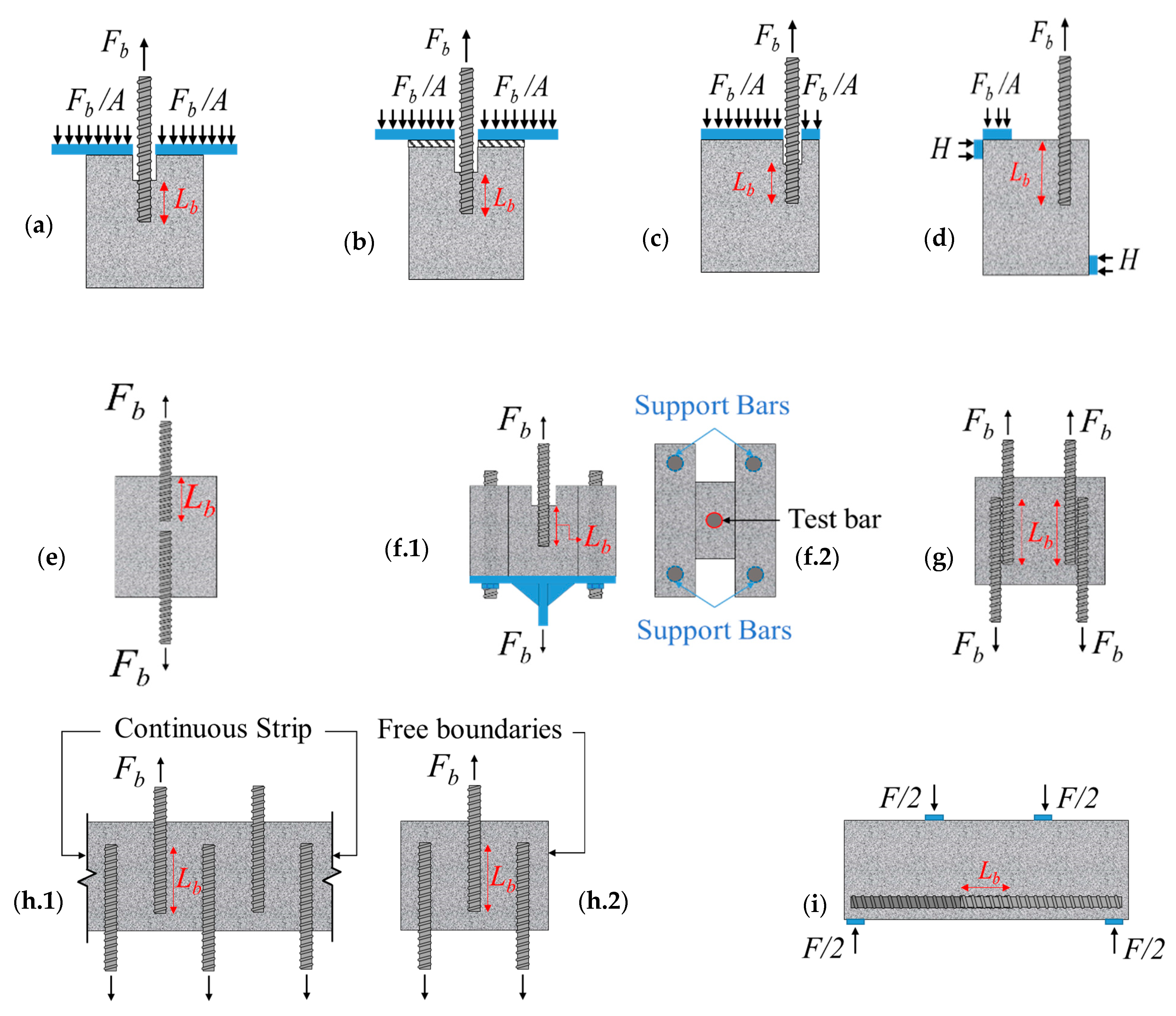

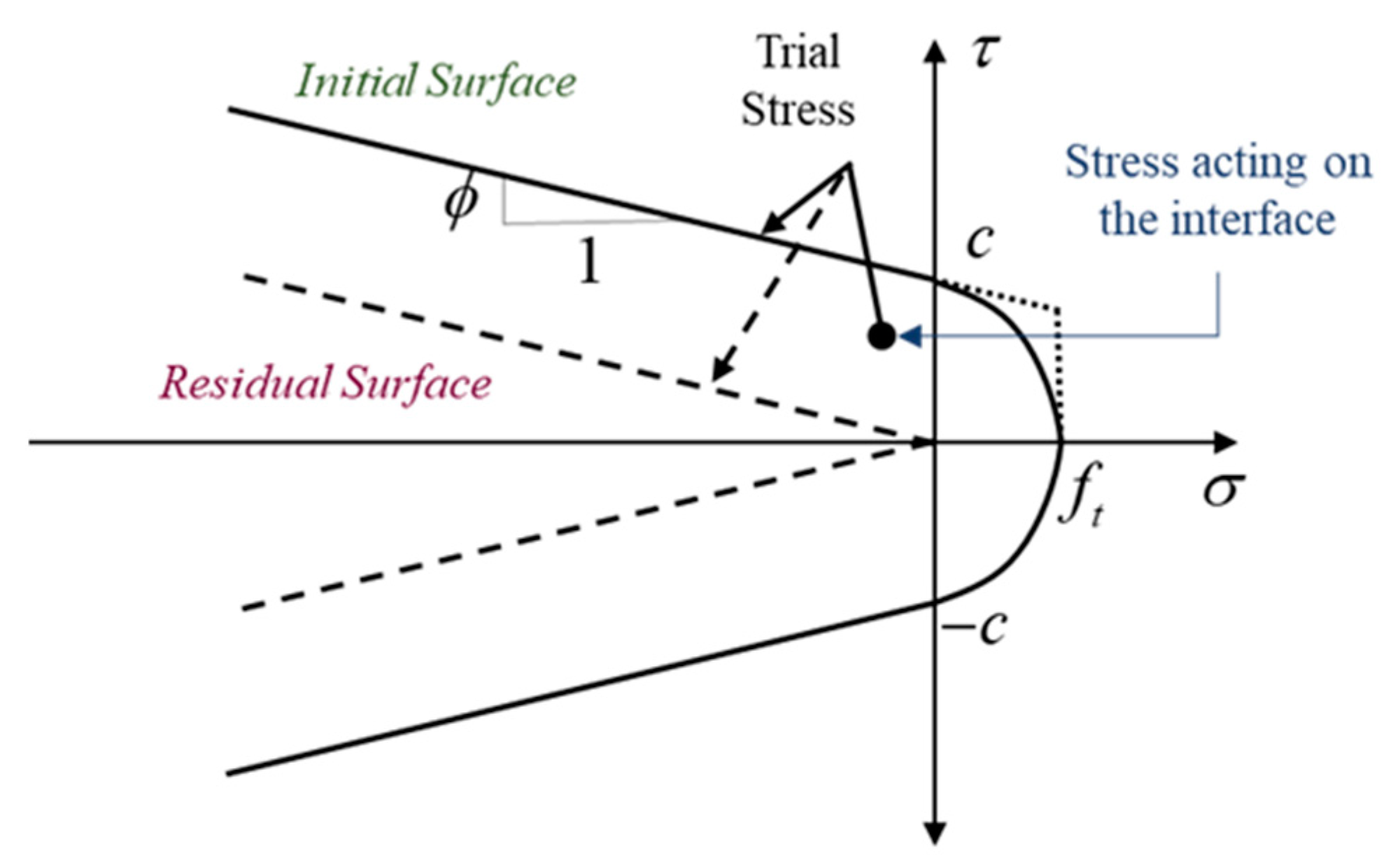

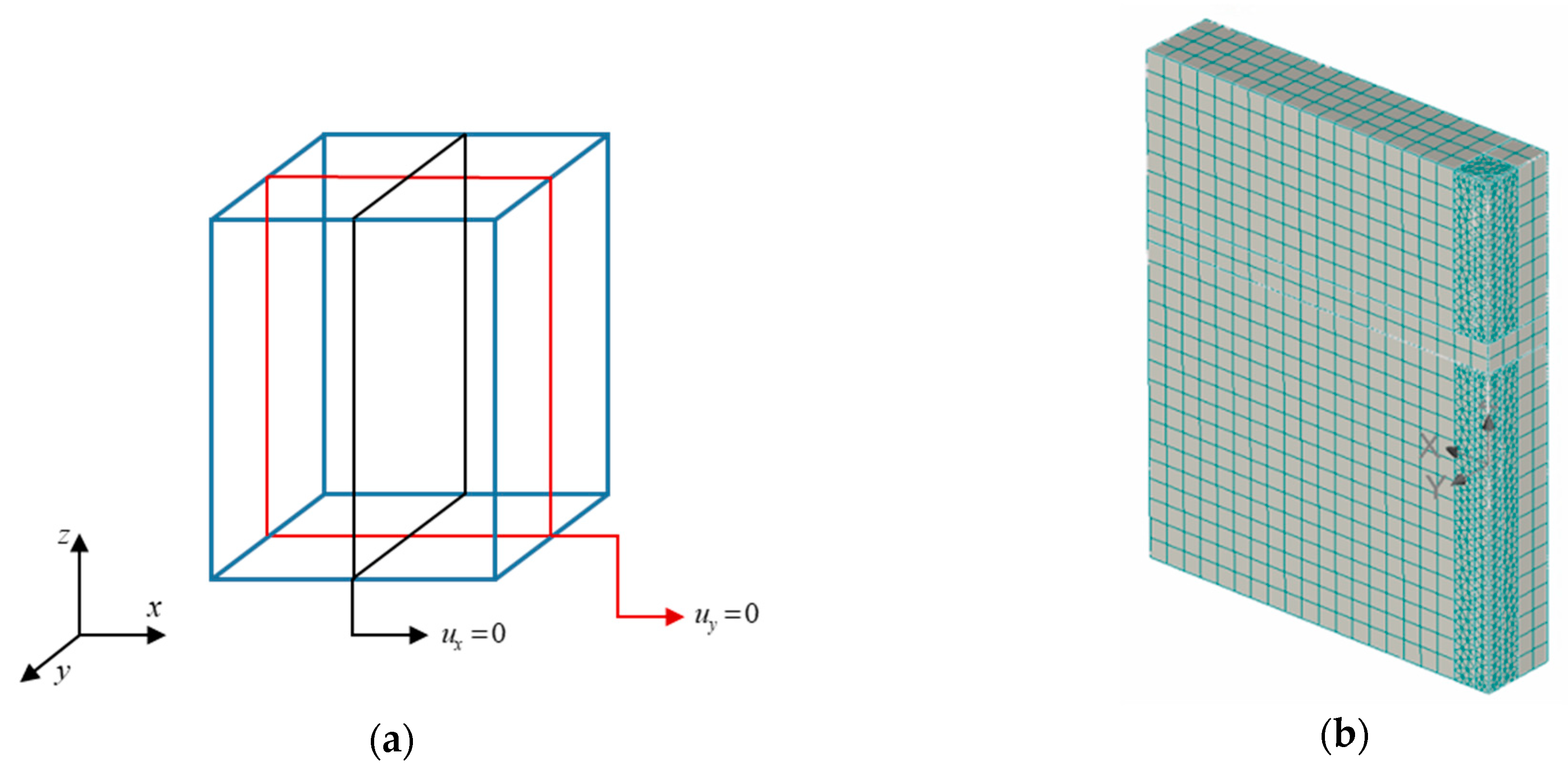
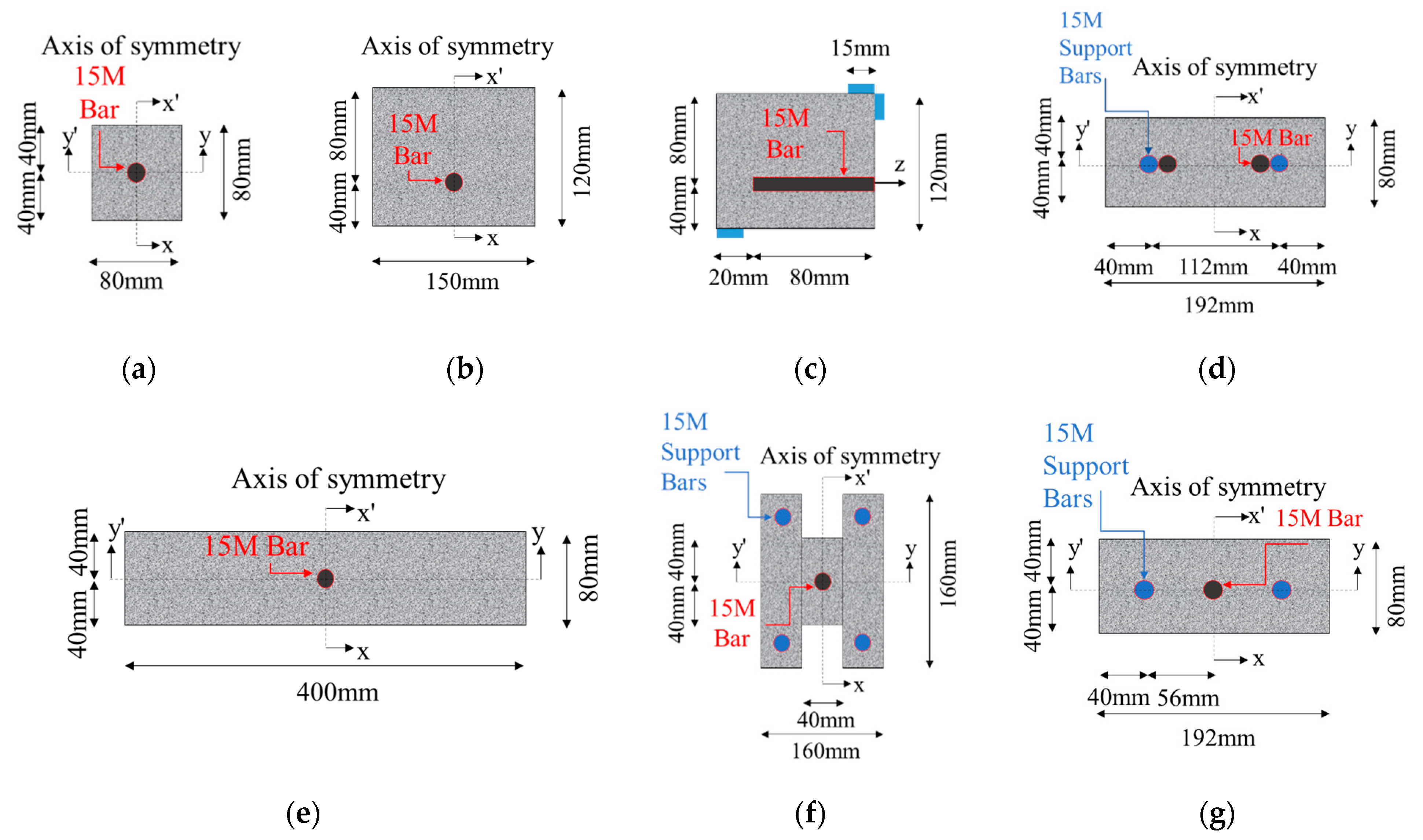

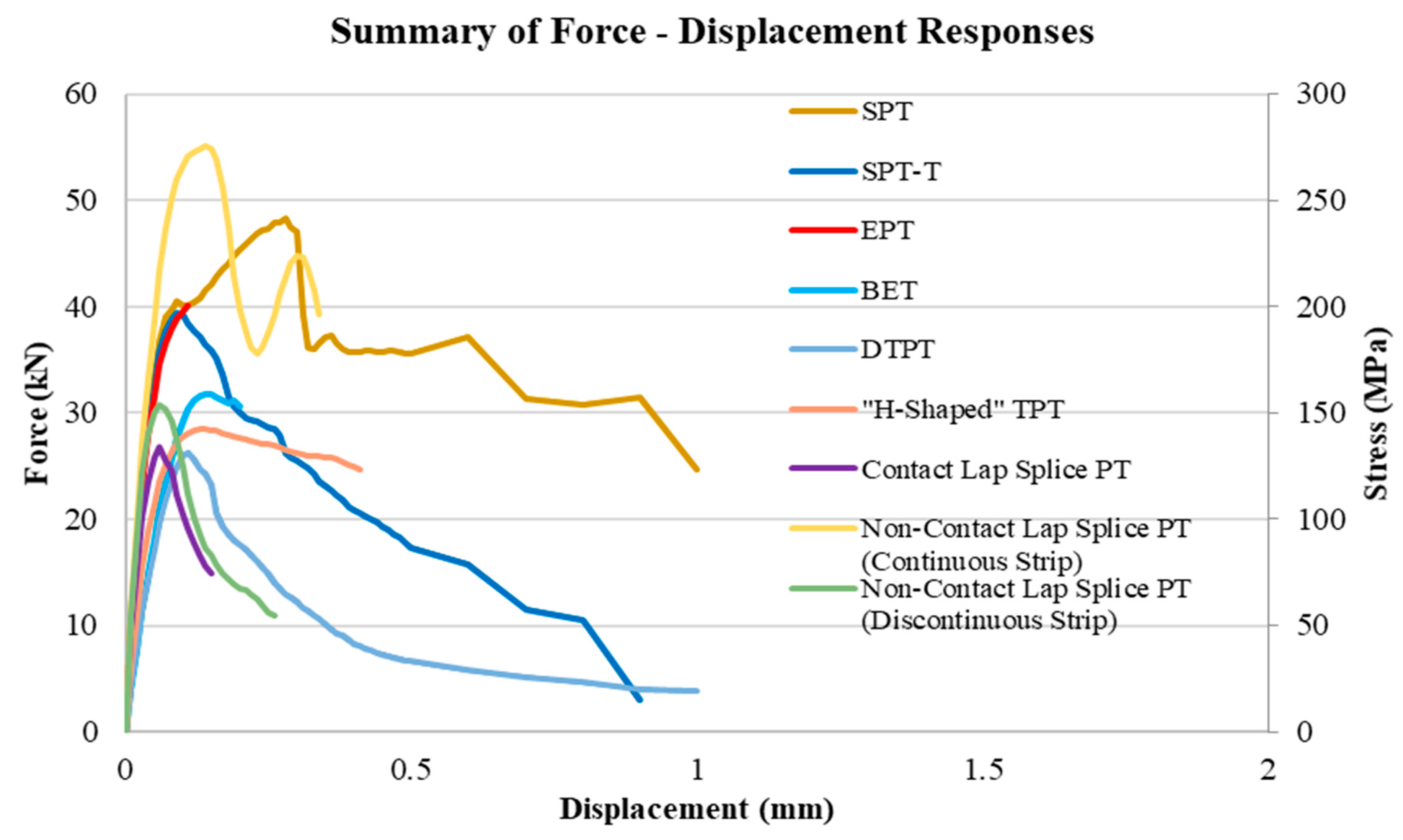

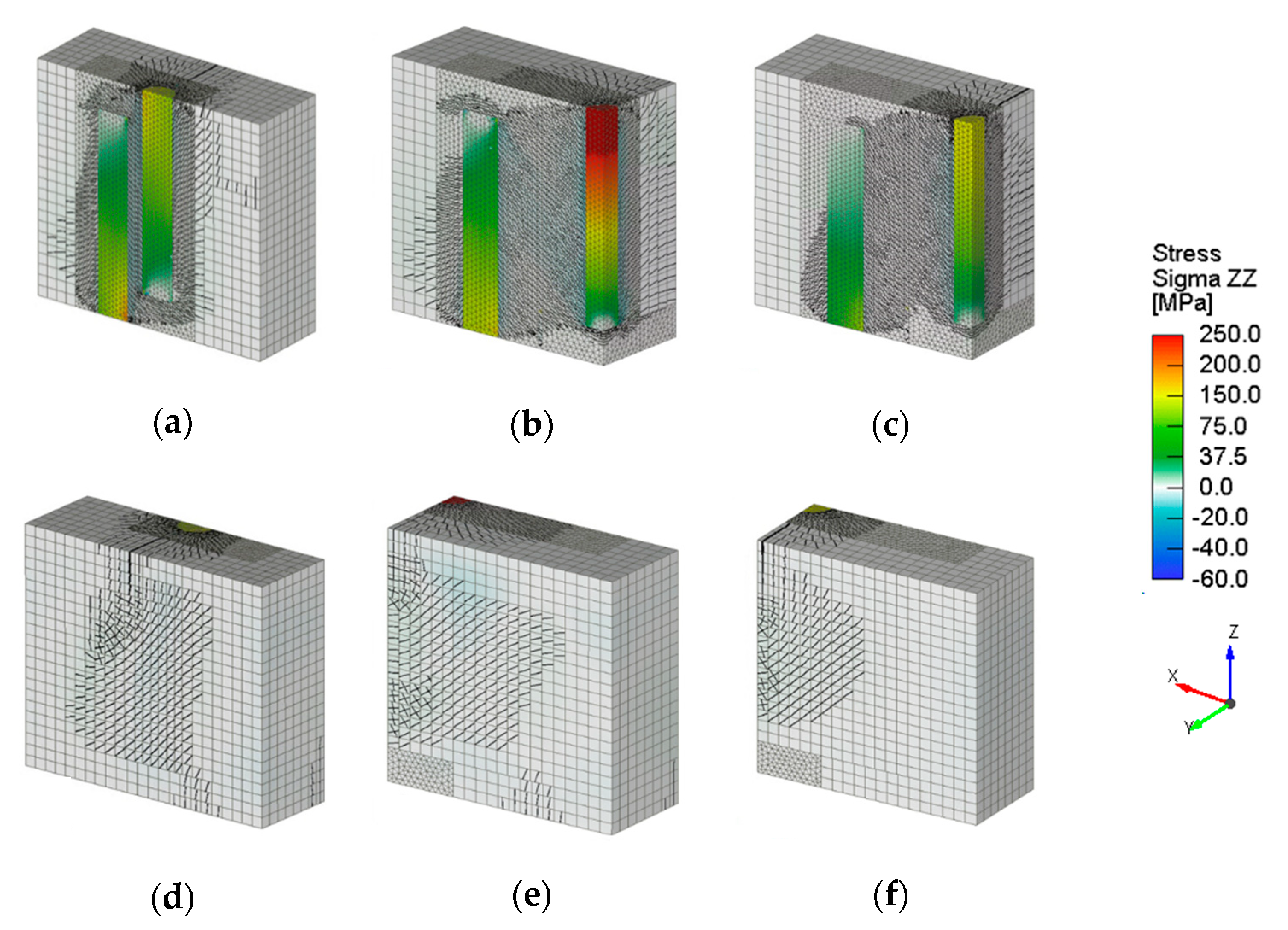
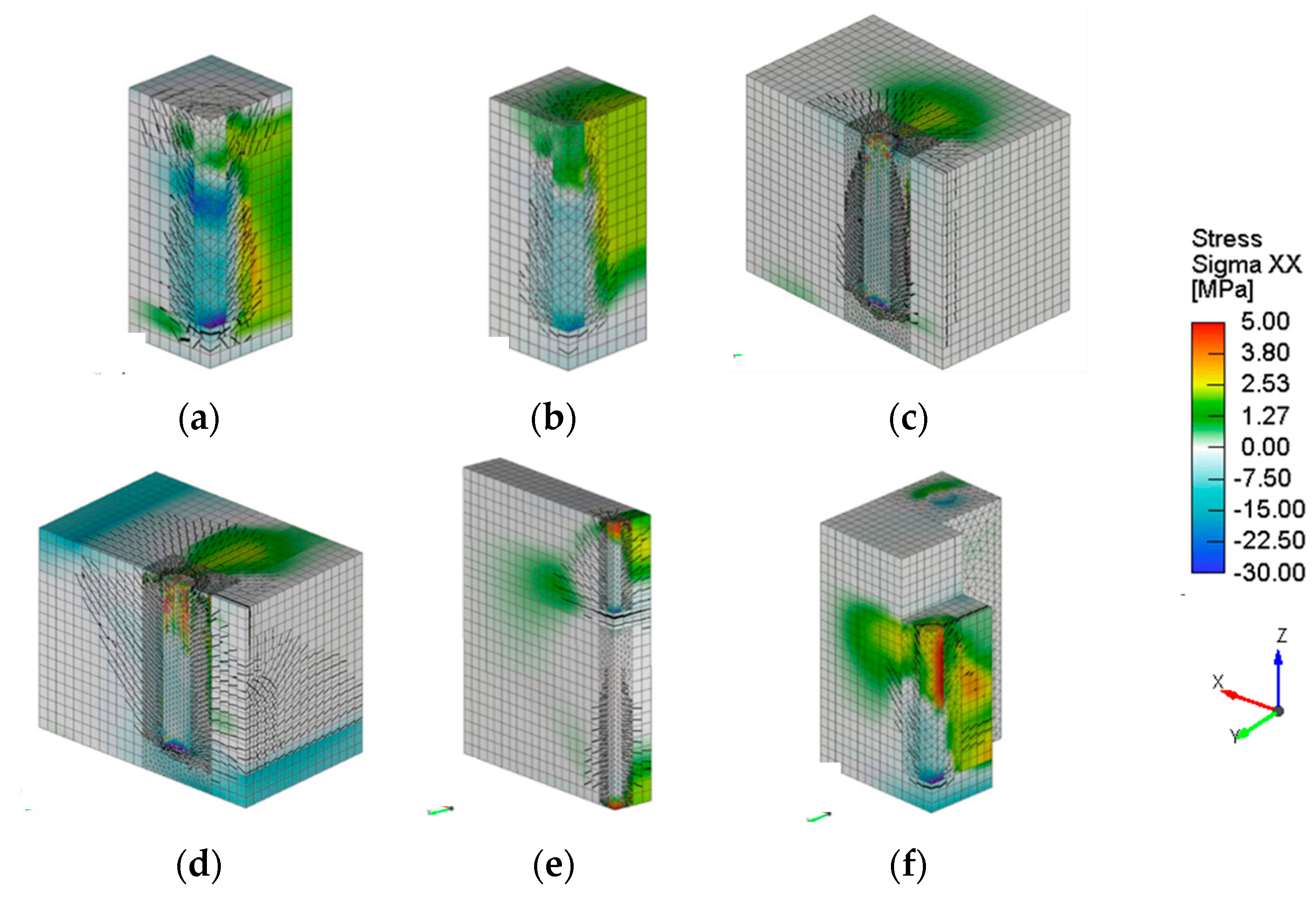
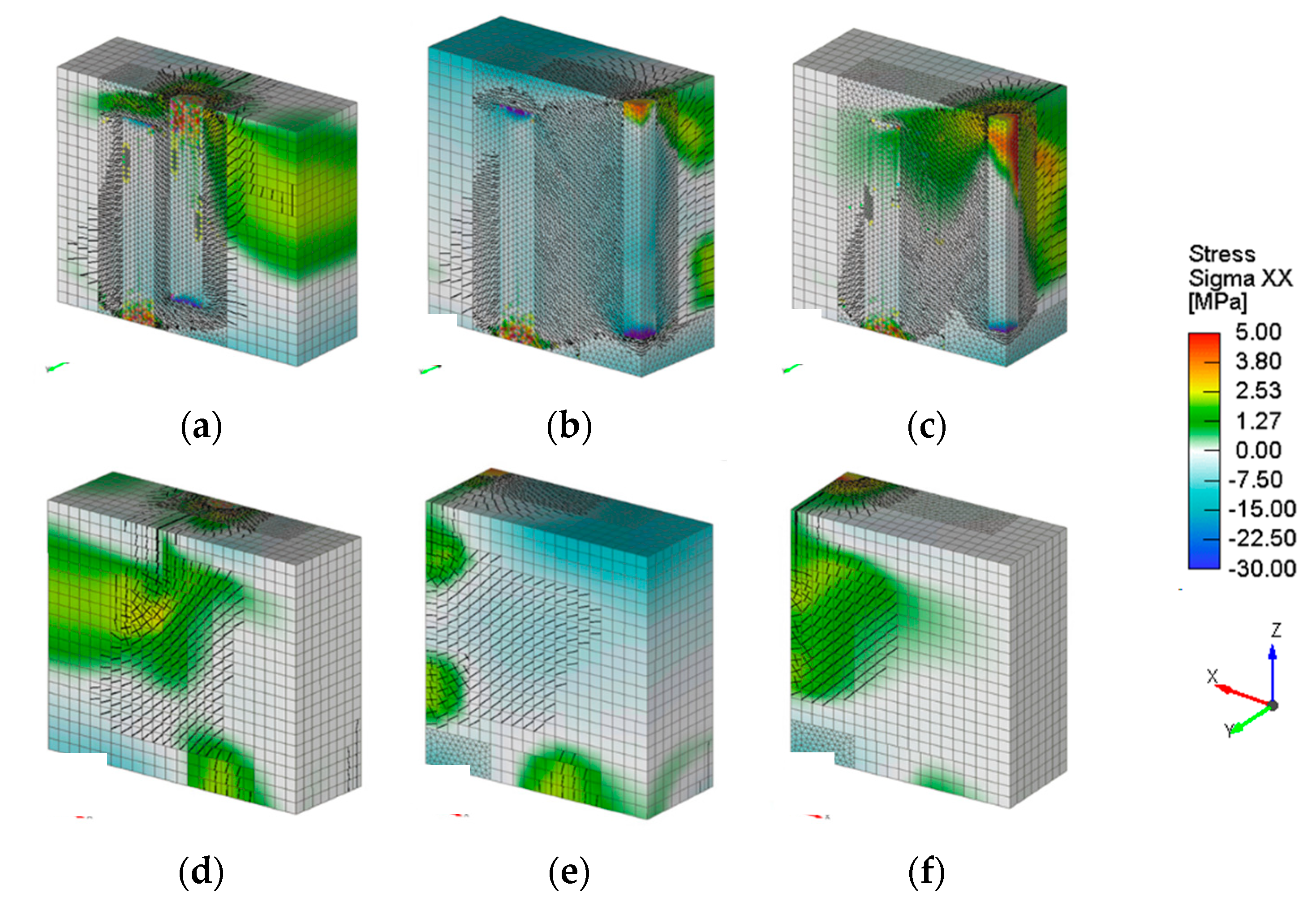

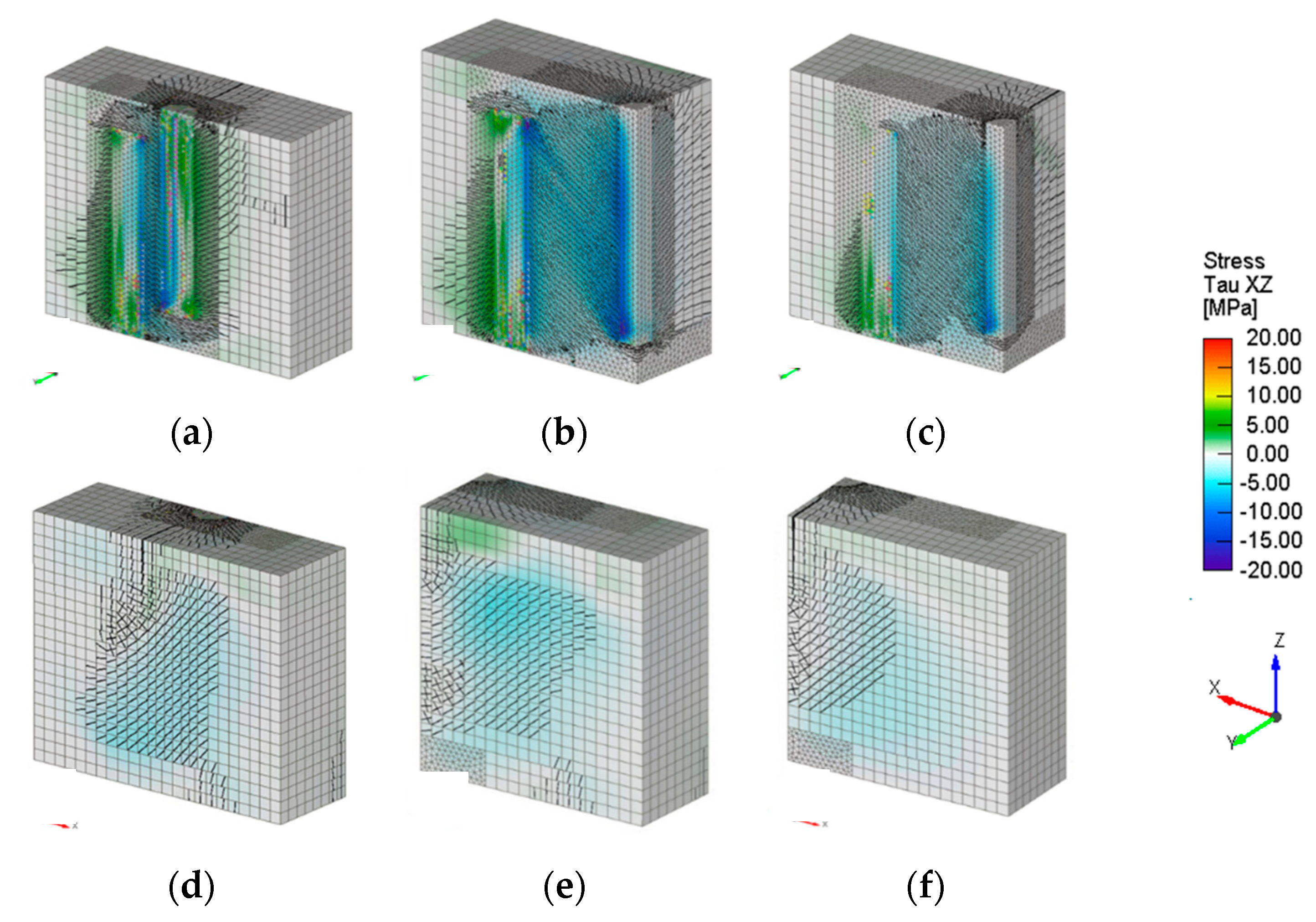
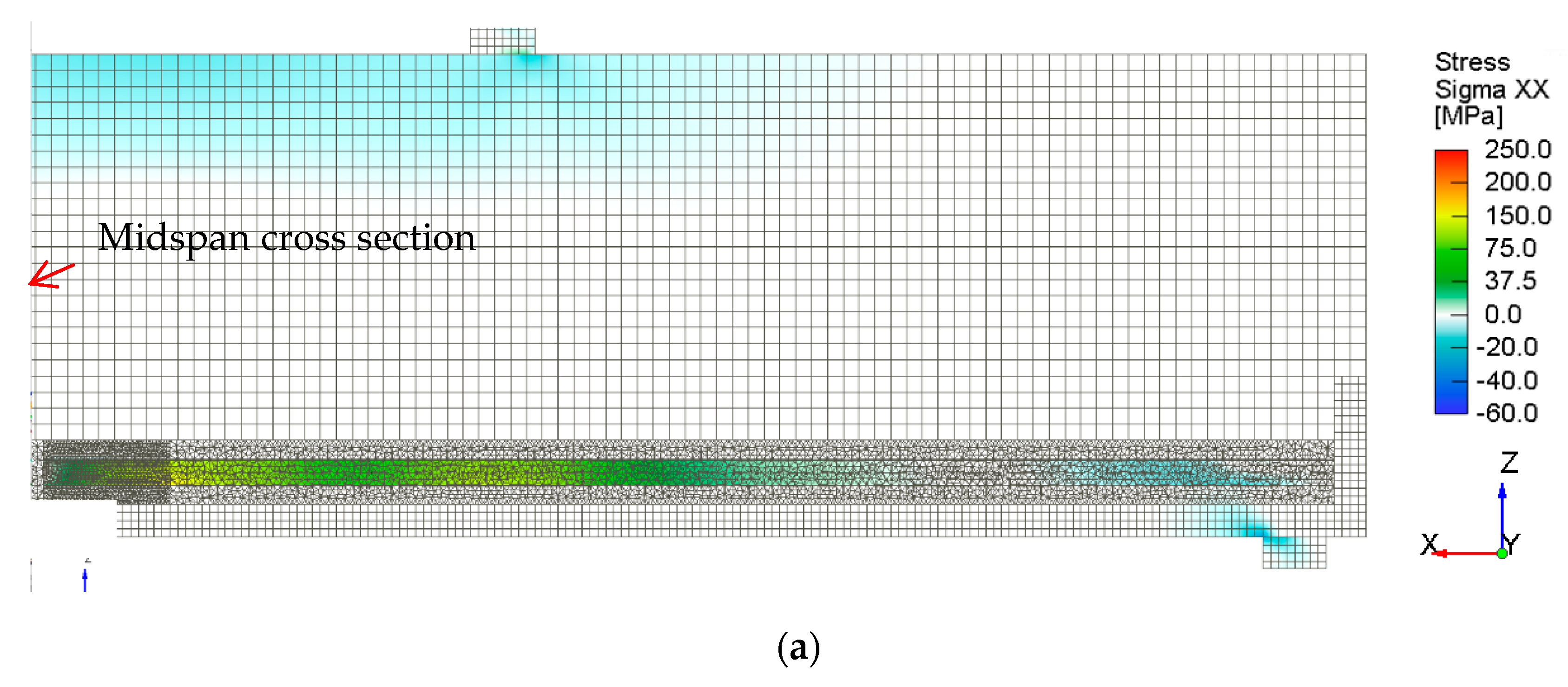
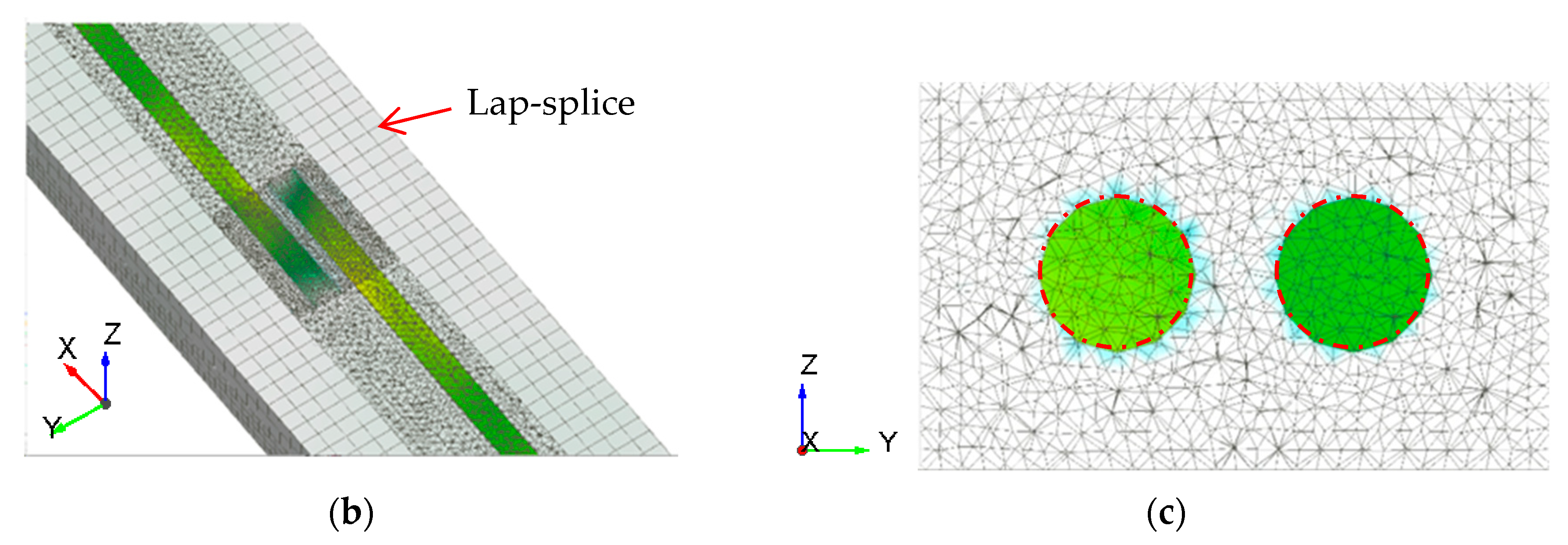
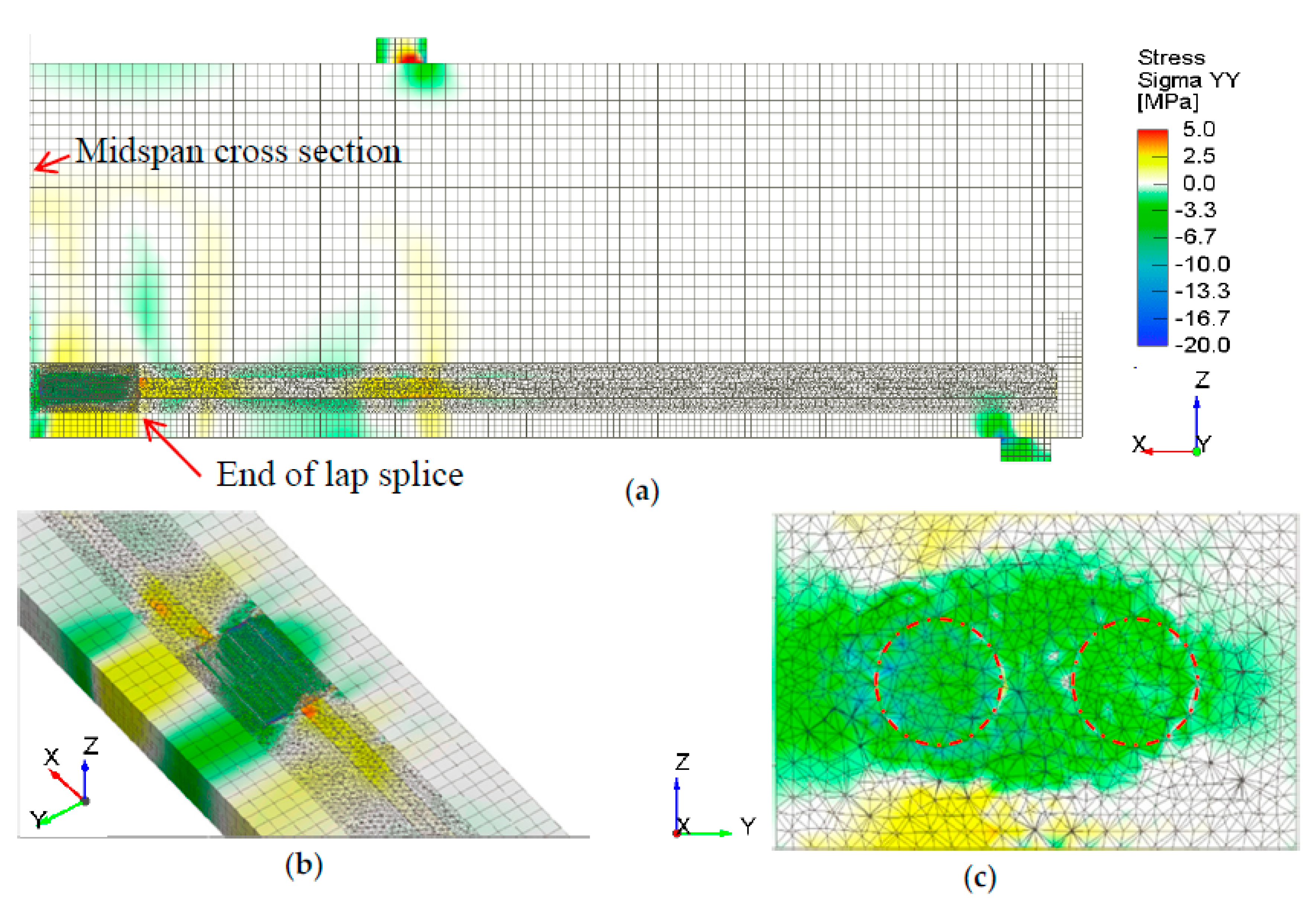
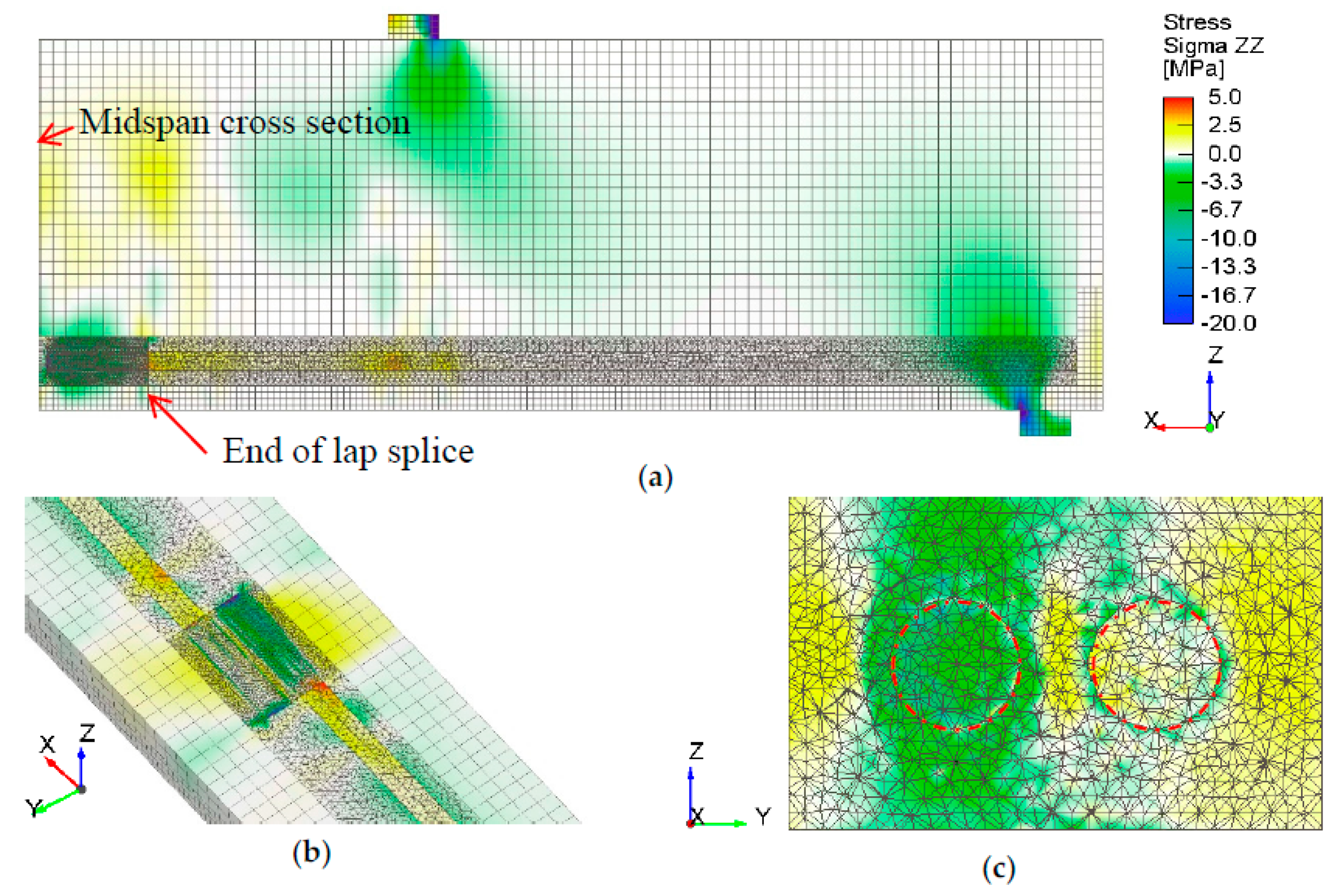
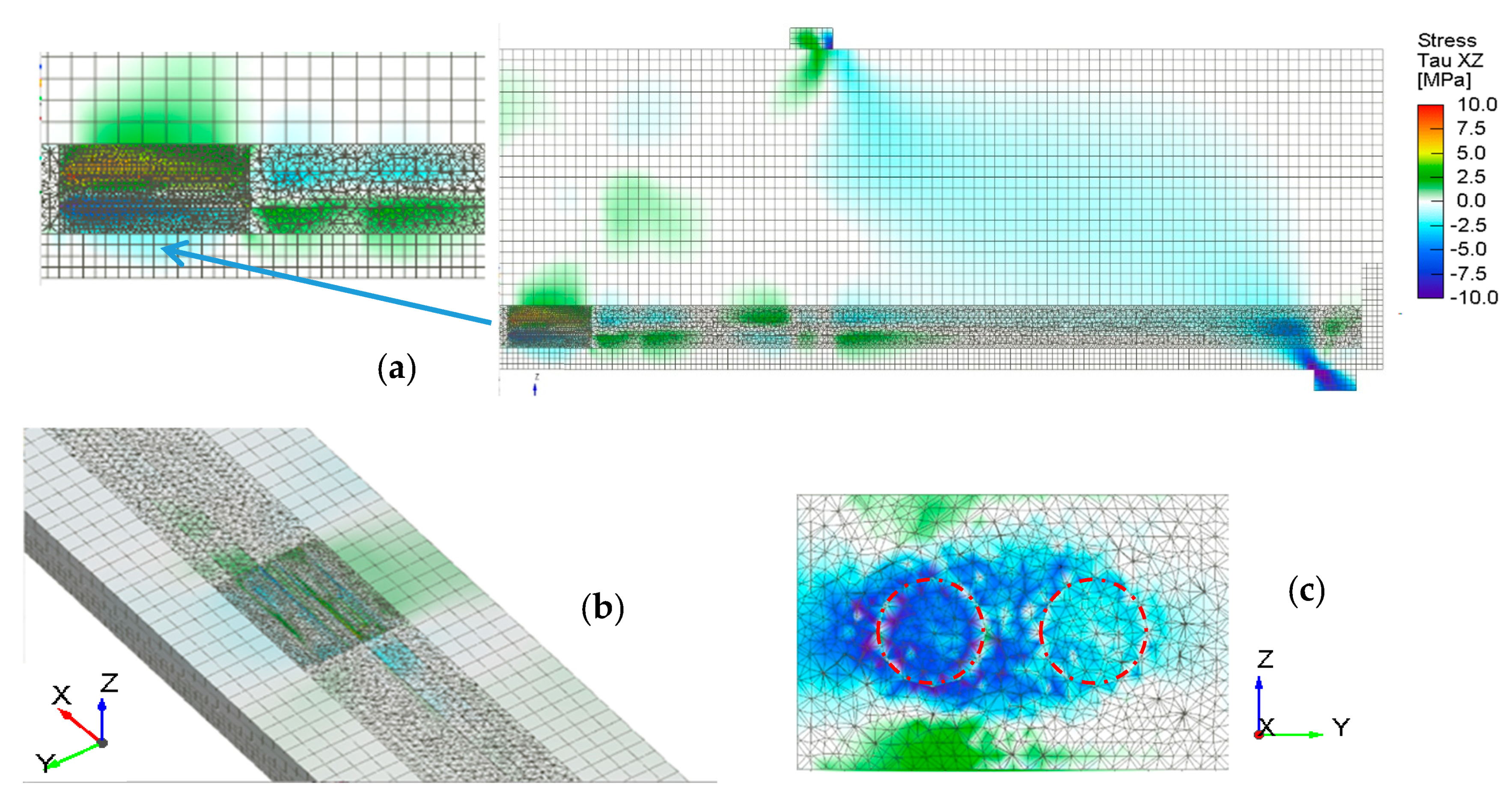
| Interface Properties | Value |
|---|---|
| Normal stiffness Knn (MN/m3) | 5.00 × 107 |
| Tangential stiffness Ktt (MN/m3) | 2.00 × 107 |
| Tensile strength ft (MPa) | 2.30 |
| Cohesion c (MPa) | 10.0 |
| Friction Coefficient tanφ | 1.00 |
| Min. Normal stiffness Knn,min (MN/m3) | 5.00 × 103 |
| Min. Tangential stiffness Ktt,min (MN/m3) | 2.00 × 103 |
| Test Setup | Max Developed Bar Stress (kN/MPa) | Displacement of Loaded End of the Bar at Peak Load (mm) |
|---|---|---|
| SPT | 48.32/241.6 | 0.28 |
| SPT-T | 39.36/196.8 | 0.09 |
| EPT | 40.04/200.2 | 0.11 |
| BET | 31.76/158.8 | 0.14 |
| DTPT | 26.28/131.4 | 0.11 |
| “H-Shaped” TPT | 28.54/142.7 | 0.14 |
| Contact Lap Splice PT | 26.7/133.7 | 0.06 |
| Non-contact Lap Splice PT (Continuous) | 55.06/275.3 | 0.14 |
| Non-contact Lap Splice PT (Discontinuous) | 30.76/153.8 | 0.06 |
Publisher’s Note: MDPI stays neutral with regard to jurisdictional claims in published maps and institutional affiliations. |
© 2021 by the authors. Licensee MDPI, Basel, Switzerland. This article is an open access article distributed under the terms and conditions of the Creative Commons Attribution (CC BY) license (http://creativecommons.org/licenses/by/4.0/).
Share and Cite
Tsiotsias, K.; Pantazopoulou, S.J. Analytical Investigation on the Effect of Test Setup on Bond Strength. CivilEng 2021, 2, 14-34. https://doi.org/10.3390/civileng2010002
Tsiotsias K, Pantazopoulou SJ. Analytical Investigation on the Effect of Test Setup on Bond Strength. CivilEng. 2021; 2(1):14-34. https://doi.org/10.3390/civileng2010002
Chicago/Turabian StyleTsiotsias, Konstantinos, and Stavroula J. Pantazopoulou. 2021. "Analytical Investigation on the Effect of Test Setup on Bond Strength" CivilEng 2, no. 1: 14-34. https://doi.org/10.3390/civileng2010002
APA StyleTsiotsias, K., & Pantazopoulou, S. J. (2021). Analytical Investigation on the Effect of Test Setup on Bond Strength. CivilEng, 2(1), 14-34. https://doi.org/10.3390/civileng2010002






